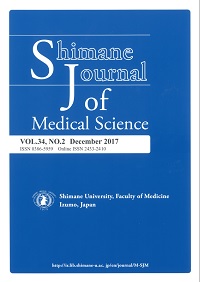Shimane University Faculty of Medicine
ISSN :0386-5959(冊子体)
ISSN :2433-2410(オンライン)


これらの論文は クリエイティブ・コモンズ 表示 - 非営利 - 改変禁止 4.0 国際 ライセンスの下に提供されています。
ダウンロード数 : ? 件
この文献の参照には次のURLをご利用ください : https://ir.lib.shimane-u.ac.jp/5878
Shimane Journal of Medical Science 19 2
2001-12-01 発行
Determination of serum C-peptide (CPR) and urinary excretion of CPR as an indicator for introducing intensive insulin treatment in patients with diabetes mellitus
ファイル
内容記述(抄録等)
Diabetic complications could be prevented orblunted by better control of blood glucose with intensive insulin therapy. However, we need to have a reliable indicator to determine the timing when one patient should be introduced into the insulin therapy.
In the present study, residual ß-cell function in the pancreas was evaluated by measuring serum Cpeptide (CPR) levels and 24 hr urinary excretions of CPR in 43 non-obese patients with diabetes mellitus (DM). All patients were initially treated with threetime daily (t.i.d.) injections of regular insulin for one or two weeks, during which period those patients whose fasting blood glucose levels being ≦1 80 mg/dl were classified into the class 1, and those being > 180 mg/dl were into the class 2. In the following study period, class 1 patients (n=18) were maintained t.i.d. regular insulin alone, while class 2 patients (n=25) received at 9:00 p.m. a single injection of neutral protamine insulin suspension in addition to the t.i.d. injections of regular insulin. Both basal serum CPR levels and urinary excretions of CPR were revealed to be much lower in the class 2 patients than in the class 1 patients (mean ± SD; serum CPR, 1.1±0.4 ng/ml for class 1 vs. 0.6±0.4 ng/ml for class 2, P<0.01; urinary CPR excretion, 40±14 μg/day for class 1 vs. 20±16 μg/day for class 2, P<0.01). Moreover, there was a significant correlation between basal serum CPR levels and the urinary CPR excretions (r=0.64, P<0.01). These findings suggest that basal serum CPR levels as well as the urinary CPR excretions are useful indicators for determining the proper timing to introduce the intensive insulin therapy into non-obese DM patients.
In the present study, residual ß-cell function in the pancreas was evaluated by measuring serum Cpeptide (CPR) levels and 24 hr urinary excretions of CPR in 43 non-obese patients with diabetes mellitus (DM). All patients were initially treated with threetime daily (t.i.d.) injections of regular insulin for one or two weeks, during which period those patients whose fasting blood glucose levels being ≦1 80 mg/dl were classified into the class 1, and those being > 180 mg/dl were into the class 2. In the following study period, class 1 patients (n=18) were maintained t.i.d. regular insulin alone, while class 2 patients (n=25) received at 9:00 p.m. a single injection of neutral protamine insulin suspension in addition to the t.i.d. injections of regular insulin. Both basal serum CPR levels and urinary excretions of CPR were revealed to be much lower in the class 2 patients than in the class 1 patients (mean ± SD; serum CPR, 1.1±0.4 ng/ml for class 1 vs. 0.6±0.4 ng/ml for class 2, P<0.01; urinary CPR excretion, 40±14 μg/day for class 1 vs. 20±16 μg/day for class 2, P<0.01). Moreover, there was a significant correlation between basal serum CPR levels and the urinary CPR excretions (r=0.64, P<0.01). These findings suggest that basal serum CPR levels as well as the urinary CPR excretions are useful indicators for determining the proper timing to introduce the intensive insulin therapy into non-obese DM patients.
About This Article
Other Article
PP. 33 - 36
